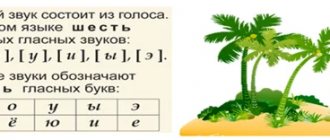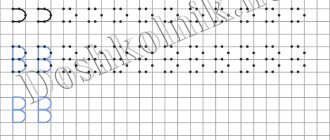§191. Definition of a common noun
1. The definition for common nouns is put in the masculine or feminine form, depending on what gender the person is denoted by this noun, for example: This simpleton is capable of confusing everything in the world (about a man); This sleepyhead sleeps all day long (about a woman); Our slut got her new dress dirty (about the girl). Wed: Kind, meek with those he loved, Ivanov was an orphan... (Garin-Mikhailovsky).
2. In colloquial speech, with nouns of the general gender, due to the presence of the ending -a , the definition is stated in the feminine form and in those cases when we are talking about a male person, for example: he is a big scoundrel, he is such a bungler. Wed: ... The insightful scoundrel, Mark (Goncharov), cynically noticed this; I am a wretched man, an endless wretched ! (Turgenev); Oh, you eternal reveler... (Ershov); Uncle... a prolific and a hero (Gorky). Wed. different forms of agreement between the definition and the predicate in a sentence: And “this hulk” [Anikanov] grabbed the hefty German... (Kazakevich).
3. Words such as celebrity, personality, person, etc., are not common nouns, therefore definitions are consistent with them according to the grammatical principle, i.e. they are put in the feminine form in cases where they denote persons male, for example: ... has appeared (Chekhov) (about Lubkov); Our celebrity did not have lunch today (Chekhov) (about Trigorin); There was in the city - a metropolitan actor.
Often in such cases, feminine nouns represent abusive nicknames or expressive characteristics, for example: But it will all end with this old woman Pyotr Nikolaevich... asking him for an apology (Chekhov).
4. Also, many masculine nouns that denote a person by profession, specialty, position held, work performed, etc., and do not have paired feminine gender equivalents, are also not words of the general gender (see §148, paragraph 1). Definitions for such words are put in the masculine form, for example: she is an experienced teacher, she is a famous master of sports. “one of ...”, which is necessary in such cases the construction “one of ...” is found, which gives the statement a colloquial tone. For example: one of the music teachers, one of the prize-winners. Such constructions do not correspond to the norms of bookish and written speech.
↑ Contents ↑
§192. Definition for a noun that has an attachment
1. When combining a generic concept with a specific one, the definition is consistent with the word denoting the generic concept, for example: a huge eucalyptus tree Japanese flower ; sea bird petrel.
2. When combining a common noun and a person’s own name, the definition agrees with the closest of the nouns, for example: attentive doctor Petrova - doctor Petrova, attentive to patients.
3. When combining a specific concept and an individual geographical name, the definition is consistent with the specific concept, for example: the highest Mount Everest, the salt lake Baskunchak, the port city of Odessa.
4. When combining a generic name and a conventional name, the definition is consistent with the generic name, for example: the popular weekly “Week”; confectionery factory "Bolshevik".
5. For complex terms such as cafe-dairy, the definition, like the predicate (see §185, paragraph 5), is consistent with the part that expresses a broader or more specific concept, for example: diet cafe- dairy , refurbished snack bar , an interesting quiz competition, a new “Roman- newspaper ”. As with the agreement of the predicate, the inclination or indeclinability of the first part plays a role; Wed: Thank you that you my bread and salt (Pushkin). – You disdain our bread and salt (V. Ovechkin). The order of the parts also has an influence, for example: Ferapontov was fat... a man , with thick lips, with a thick bump -nose... (L. Tolstoy).
6. With complex units of measurement, the numeral agrees with the second (declinable) part, for example: one volt- second , one gram- molecule .
7. inflected abbreviations, the definition is consistent according to the grammatical principle, for example: capital university , durable bunker . indeclinable abbreviations, the definition is consistent with the leading word of the expanded compound name, for example: Bratsk hydroelectric power station , but local general store .
↑ Contents ↑
§193. Definition for a noun depending on the numerals two, three, four
1. For masculine and neuter nouns that depend on the numerals two, three, four (as well as on compound numerals ending in the indicated numbers), the definition located between the numeral and the noun in modern language is usually put in the form of the genitive case plural: two tall houses, three large windows, twenty-four wooden tables. For example: ...The officers ate greedily, without talking, making up for two lost in battle (Sholokhov); The two outer windows on the first floor are closed from the inside with newspaper sheets... (A.N. Tolstoy).
2. For feminine nouns in the specified conditions, the definition is often put in the form of the nominative case (or the accusative case coinciding with it for inanimate nouns) plural. For example: two large rooms overlooked the garden; bought four porcelain cups; female sat on a fence of three poles (A.N. Tolstoy); large are moving along these roads (M. Bubennov).
If there is a preposition before the whole phrase, options are possible; compare: into two equal parts - two tablespoons .
If the forms of the nominative plural of feminine nouns differ in stress from the form of the genitive singular (cf.: mountains - mountains, tears - tears), then the definition in the construction in question is usually put in the genitive plural: two high mountains, two large tears. For example: Three sulfur strings stretched in the air (Gorky); Two strong male hands grabbed her (A. Koptyaeva).
The choice of the form of definition may be influenced by the form of the predicate; Wed: Three gold medals were won. – Three gold medals were won.
3. Possessive adjectives ending in -i n and -ov are usually placed in the genitive plural, regardless of the grammatical gender of the noun: two grandmother’s sundresses, three sister’s friends, two devil’s gorge.
Possessive adjectives in -i й , -я, -е, as well as the ordinal number third , agree depending on the gender of the noun being defined: two fox tails, two crow’s nests, two bear dens; two third prizes – two third prizes.
4. If the definition comes before the counting phrase, then it is put in the nominative case form, regardless of the gender of the noun: every two hours , the last two sentences , the best two songs . For example: For the first three years , she only visited Zabolotye in fits and starts (Saltykov-Shchedrin); The last two words were written in a large and sweeping, decisive hand (Turgenev); The remaining three horses ... walked behind (Sholokhov).
However, the adjectives whole, complete, kind and some others are usually used in this case in the form of the genitive case: whole months, whole weeks, full buckets, a good two days, an extra three hours. For example: ...I was sometimes forced whole hours, pressed against the wall (Pushkin); And he beat me for about two months (Dostoevsky).
In combination with one and a half ( one and a half ), both forms of agreement are possible: a good half hour - a good half hour (see also §168, paragraph 2), a whole week and a half - a whole week and a half.
1. If a definition (usually isolated) comes after a counting phrase, then more often it is put in the nominative plural form, for example: To the right of the door there were two windows hung with scarves (L. Tolstoy); The last two letters, written in pencil, scared me (Chekhov); ...Two huge tarred troughs, leaning on top of each other... sticking out at the very exit into open water (Fedin); Two trucks loaded with flour drove up to the collective farm barn (Yu. Laptev).
2. For substantivized adjectives of the masculine and neuter gender, the definition is put in the genitive plural form: two random passers-by, three dietary second (about the dish), four experienced workers.
With substantivized feminine adjectives, both forms of agreement are possible: two neighboring dining rooms - two neighboring dining rooms, three large boiler rooms - three large boiler rooms. If the definition is prepositive, then the nominative case form is used: the neighboring two bakeries, the best three pastry shops.
If a substantivized feminine adjective is used without a definition, then it more often takes the form of the nominative plural: there are two bathrooms laundry rooms are additionally designed . As a direct object, the genitive form is possible: three more canteens laundries equipped . With different prepositions, options are also possible; Wed: the equipment is designed for three laundries , four hairdressing salons - in each microdistrict there will be three laundries , four hairdressing salons .
As with the choice of the form of definition, the influence of the form of the predicate can be felt here; Wed: Two draws were recorded. – Two draws were recorded.
3. When naming a fractional number (the denominator is a substantiated feminine ordinal number), the genitive case form is used: Two- fifths of the Moon are hidden from our view.
↑ Contents ↑
What is an adjective and its agreement with a noun
Good afternoon, dear student!
Today I would like to write a little about the adjective name in Russian. For Russian-speaking people, an adjective denotes a characteristic (of a person or an object), but the most important thing that needs to be remembered and always known is that the adjective agrees in gender, number and case with the noun. What does this mean, you ask? Adjectives are almost always used in a sentence together with a noun, for example:
Nice dress
(A beautiful dress) = beautiful [krasivae] is an adjective + dress [plat'e] is a noun In this sentence, an adjective and a noun are a pair. So, before determining the form of the adjective and putting the correct ending, we must look at the noun that is paired with it - we need to determine the number, gender, case. In our example, the noun is singular, neuter and nominative.
To correctly put endings in adjectives, let's decline a few examples by case:
1. Nominative
[Iminitel'nyj padezh] – Nominative case
This is new AYA
bag – This is a new bag
We see that the noun bag is feminine, singular, and we know that the feminine gender usually has the endings - A/Z
, accordingly, we put a similar ending in the adjective (see the article about adjectives using the example of flowers)
2. Genitive
[Raditel'nyj padezh] – Genitive case I don’t have a new
pencil
– I don’t have a new pencil
In this example, we see that the word “pencil” is in the genitive case, accordingly, we put the adjective in the same form and, if the adjective is in the genitive case, it takes on the ending - OGO
, because “pencil” is masculine.
3. Dative
[Datel'nyj padezh] – Dative case
I approached a beautiful WMD
tree – I came to the beautiful tree.
In the dative case, the adjective will end with the ending OMU, because the noun “tree” is neuter.
Thus, you can make a table (in the Nominative case), which will reflect important changes in the endings of adjectives by gender:
Article source: https://www.ruspeach.com/learning/13084/
§194. Two definitions for one noun
1. A noun preceded by two or more adjectives indicating the types of objects is put in the singular form:
1) if the noun is not used in the plural form, for example: scientific and technical progress; ferrous and non-ferrous metallurgy; weightlifting and athletics ; political , economic and cultural cooperation of European countries. Incorrect therefore: “Espionage is most common in the automobile, oil and chemical industries .” Should: in... industry .
The predicate in these cases is put in the singular form, grammatically consistent with the subject-noun having the form of the same number, if the commonality of the listed objects or phenomena is shown, for example: Atomic and hydrogen weapons must be destroyed . If the independent nature of the subjects of the action-state is emphasized, then the predicate is put in the plural form, for example: Heavy and light industry need reconstruction; Descriptive and historical phonetics have a separate specific language as their object of study;
2) if a noun in the plural has a different meaning than in the singular, for example: the economic and cultural rise of the country (cf.: steep descents and ascents ); railway and water transport (cf.: transports with weapons); state and cooperative trading network (cf.: fishing nets ); youth and student movement (cf. movements ); conservative and liberal press (cf.: seal ); Catholic and Protestant churches (cf. ancient churches ); primary and secondary education (cf.: mountain formations ).
The predicate in these cases is consistent in meaning and is put in the plural, for example: The left and right wings of the democratic movement cannot come to agreement;
3) if there are adversative, divisive or comparative conjunctions between the definitions, for example: not Norwegian, but Dutch speed skater ; Latin or Gothic script ; sometimes wide, sometimes narrow road ; both last year and this year ; if not in the neighboring region, then in a more distant region ;
4) if the listed varieties of objects or phenomena are internally related, for example, in combinations of a terminological nature: cf.: in the right and left hand ( half, side, etc.); opera and ballet art ; industrial and agricultural revolution ; students of middle and high school age ; programs for eight-year and secondary schools (as education systems); in Old Church Slavonic and Old Russian book language ; perfect and imperfect verbs ( active and passive voice , present and past tense , indicative and subjunctive mood , first and second conjugation , etc.); masculine , feminine and neuter nouns ( first and second declension , singular and plural ) ; person pronouns ; viral and simple flu ; brain and spinal cord ; War of the Scarlet and White Roses .
Wed. also: The city was open to winds from the north and east .
The predicate in these cases is put in the plural form, for example: The right and left half of the house were illuminated ; The past and future tenses of a verb indicate the preceding and subsequent action in relation to the moment of speech;
5) often, if the definitions are expressed by ordinal numbers or pronominal adjectives, for example: workers of the first and second shift ; construction of the first and second stages of the plant; chess players of the first and second categories ; the bullet passed between the fifth and sixth ribs ; the similarity between your handwriting ; in both cases ; for both teams . The form of the case plays a role; compare: first and second floors - between the first and second floors (plural form in the nominative case and singular form in the oblique case).
The predicate in these cases is put in the plural form, for example: The first and second days passed calmly; My mom and your mom were worried about us.
In the presence of cardinal numerals in such constructions, the form of the defined noun depends on the form of the last component, for example: The front consisted of thirty separate tank and twenty-two cavalry corps ; The apartment consists of three light and one dark room ; Additionally, ten food stores and three department stores ;
6) in combinations of the type at the end of the 19th and beginning of the 20th centuries: the homogeneous members here are the nouns beginning and end, and not ordinal numbers. The same is true in expressions like from the North to the South Pole: there is no coordinating connection between the adjectives.
2. The noun is put in the plural form:
1) if the presence of several items is emphasized, for example: Moscow and Gorky automobile plants ; biological and chemical methods ; academic and mass editions of classic works, widescreen and regular versions of the film; manganese and chrome ores ; hydrochloric and sulfuric acids ; forging and press and assembly shops ; gold and silver medals ; hydropower and irrigation systems ; turning and milling machines , chassis and conning tower of the cruiser; sheep and calf skins , the gap between the first and last riders , meetings with the Bulgarian and Polish football teams ; participants in the Civil and Great Patriotic Wars .
The meaning of plurality can also have an impact in cases where definitions are expressed by ordinal numbers, for example: the first and second world wars ; radio observations of signals from the first and second artificial satellites ; first and second editions of the novel; the second and third groups of the graduating year, third, fourth and fifth places were shared...; coincides with the first and second stages . Wed: prefects of the eighth and ninth grades (disaggregated concept) - he was an excellent student in the eighth and ninth grade (concept of the whole);
2) if there is a previous definition in plural form, for example: new world and domestic records ; Old Russian first and second declension ;
3) if the defined noun comes before the definitions, for example: forms of the active and passive voices.
↑ Contents ↑
Speech therapist's notes on agreeing adjectives with nouns
Topic: Agreement of adjectives with nouns in gender and number. “Which one, which one, which one, which one?”
Preliminary work:
- the concepts of “noun” and “adjective” have been mastered. - the concepts of “masculine, feminine and neuter gender” have been mastered. - the concepts of “singular and plural” have been mastered. — work has been done on differentiating nouns and adjectives, agreeing adjectives with nouns in gender and number.
Equipment:
Subject pictures, posters with words, diagrams, tables, colored pencils, ball.
Program content:
- continue to teach children to determine the gender of nouns and adjectives using questions - whose? whose? whose? whose? and which? which? which? which? - continue to develop the ability to select pronouns - mine, mine, mine, mine to nouns; - develop the ability to construct grammatically correct phrases and sentences; — strengthen children’s skills in agreeing adjectives with nouns in gender and number; — develop attention, thinking, memory, skills and techniques of self-control; - develop children's vocabulary; - develop communication skills and correct behavior.
Methods and techniques:
Verbal and visual methods, self-control method.
Lesson plan:
- Organizing time.
- Breathing exercises. Speech gymnastics.
- Working with pictures.
- Determining the topic of the lesson.
- Independent work. Game "Colored cells".
- Game "Fourth wheel".
- Physical education minute.
- Guess game.
- Working with cards.
- Game "Traffic Light".
- Physical education minute.
- Ball game: “Which one, which one, which one, which one?”
- Antonyms.
- Relaxation exercises.
- Summary of the lesson.
Progress of the lesson
1. Organizational point:
Guys, look, is everything ready for class? Is everything in its place?
2. Breathing exercises. Speech gymnastics.
In order for us to pronounce words beautifully and clearly, we need to prepare our articulation apparatus for work. Let's show how we can breathe correctly and pronounce pure phrases.
A set of breathing exercises “Who and how?” How does the dough puff? Puff-puff-puff... How does a locomotive release steam? Chug - chug - chug... How does a goose hiss? Shhhhhhhhhhhhhhhhhhhhhhhhhhhhhhhhhhhhhhhhhhhhhhhhhhhhhhhhhhhhhhhhhhhhhhhhhhhhhhhhhhhhhhhhhhhhhhhhhhhhhhhhhhhhhhhhhhhhhhhhhhhhhhhhhhhhhhhhhhhhhhhhhhhhhhhhhhhhhhhhhhhhhhhhhhhhhhhhhhhhhhhhhhhhhhhhhhhhhhhhhhhhhhhhhhhhh……how we laugh? Ha-ha-ha...... How do we pump up the pump? Sssssssssssssss…. How do we blow on a dandelion? Fffffffff…..
Well done. And now, we will correctly, clearly and beautifully read the pure saying that I wrote down on the board.
Speech gymnastics: Four little black little devils drew a drawing in black ink...
Well done. Now, you are ready for class.
3. Working with pictures:
Guys, I have pictures hanging on my board. I need your help. Tell me, what items can I say mine? - raincoat, umbrella, computer, briefcase, backpack. Mine? - car, jacket, shirt, pen, book. Mine? - gun, ring, feather, bucket, piano, coat. What type of first group of objects? Male. Second? Female. Third? Average.
4. Determining the topic of the lesson:
Today we will continue to work with masculine, feminine and neuter nouns and adjectives. We will make up word combinations and work in groups. Topic: Agreement of adjectives with nouns in gender and number.
5. Independent work. Game "Colored cells":
You have assignment sheets and colored pencils on your desks. Instructions: color all feminine words red, masculine green, neuter yellow.
| Tomato | Milk | Grass | Sky | Cheese | Mother |
| Apple | Mandarin | Notebook | Dictionary | Window | Mirror |
| Dog | Cat | Meat | Calendar | Pen | Class |
| School | Airplane | Song | Bag | Sun | Rose |
6. Game "Fourth wheel":
Instructions : name the 4th extra one, explain why?
1. Magpie, wolf, bear, lion. Soroka - because she is female. 2. Cow, fox, dog, tiger. 3. Cabbage, eggplant, tomato, potato. 4. Apple, apricot, peach, orange. 5. Currants, sea buckthorn, cherries, gooseberries. 6. Zucchini, turnips, beets, radishes. 7. Lemon, peach, orange, pear. 8. Turnips, garlic, lettuce, cucumber. 9. Melon, grapes, lemon, watermelon. 10. Chicken, bullfinch, goose, sparrow. 11. Woodpecker, tit, swallow, magpie. 12. Horse, dog, cow, pig. 13. Fox, hare, wolf, bear.
7. Physical school Are you probably tired? Well, then everyone stood up together. They stamped their feet and clapped their hands. They twirled and twirled and everyone sat down at their desks. We close our eyes tightly and count to 5 together. We open it, blink and continue working.
8. Game "Guess":
While you were resting, fairy-tale heroes came to us. We have to guess them. Answer, about whom we can say this: - tiny, caring, kind - Thumbelina. - stupid, restless, curious - Dunno. - long-nosed, wooden, mischievous - Pinocchio. - beautiful, elegant, well-mannered - Malvina. - gray, hungry, angry - Gray Wolf. - red-haired, cunning, insidious - Fox. - fat, agile, funny - Carlson. - green, big, kind - Crocodile Gena. - lop-eared, clumsy, brown - Cheburashka. - wild, brave, dexterous - Mowgli.
9. Working with cards according to options:
Option 1: Tiger cub
The father brought the tiger cub from the hunt. He had a large ____ head, round ____ greenish ___ eyes, a wide ____ forehead, short ____ ears. The front _____ paws were heavy_____ and strong_____. He was clumsy _____ and small _____. The tiger cub was caught in the reeds near the huge ____ lake.
Option 2: Tit
A tit is a small____ bird. She is smaller than a sparrow. She has a black______ head and white____ cheeks. The breast is yellow______, and the back is greenish_____. Forest tit___ bird.
Option 3: Flowers are blooming
Happy ____ May is coming. The white___ lily of the valley, the yellow___ buttercup, and the blue___ bell will bloom. A red _____ peony and a white _____ lily will bloom in the garden. In summer, bright____ rose hips and pink____ clover will bloom.
Cards are distributed according to options and completed independently by children.
10. Game "Traffic Light":
Instructions: divide the objects into groups - by color: Questions: which, which, which, which?
Green Christmas tree, green cabbage, green crocodile, green overalls, green leaf, green cucumbers. Yellow camel, yellow banana, yellow pear, yellow pencil, yellow bun, yellow gooseberry, yellow lemon, yellow dandelion, yellow towel, yellow turnip, yellow sun, yellow duckling, yellow chicken. Red cherries, red watermelon, red carnations, red ball, red chair, red car, red pepper, red dress, red tomatoes, red vacuum cleaner, red rowan, red sundress, red tram.
11. Physical school
We have a physical education session again, we bent down, come on, come on! They straightened up, stretched, and now they bent back. (bends forward and backward) We stretch our arms and shoulders, so that it is easier for us to sit, to write, to read. Count and not get tired at all. (jerks with hands in front of chest) My head is tired too. So let's help her! Right, left, one and two. Think, think, head. (rotate head) Although the exercise is short, we rested a little (sit down at their desks)
12. Playing with a ball: “Which one, which one, which one, which one?”
Instructions: throw the ball, calling a noun. The child must choose the correct adjective for it, in the appropriate gender and number:
The ball is rubber, the chair is wooden, the sun is bright, candy is sweet, the car is fast, mother is kind, the lion is formidable, etc.
13. Antonyms:
Instructions: say the opposite. Selection of antonyms, work with cards:
Big - small Thick - thin Hungry - well-fed Dull - sharp Hard - soft Wide - narrow Short - long Cheerful - sad Light - heavy Clean - dirty Good - evil
14. Relaxation exercises:
You are probably tired, let's rest and relax?
Set of exercises: “Dropping your arms” - raise your arms to the sides and bend slightly forward. Hanging, the arms swing slightly passively until they stop. You can suggest to the children an image - hands hanging like ropes. “Shaking our hands” - the arms are bent at the elbows, the hands hang passively. With a quick and continuous movement of the forearm, shake your hands like rags. “Shake off the water from our fingers” - arms bent at the elbows, palms down, hands hanging down. By moving your forearm, lower your hands down several times. Before the exercise, it is useful to invite children to tightly clench their hands into a fist so that the difference in the tense and relaxed state of the muscles can be more clearly felt. “Raise and lower the shoulders” - raise the shoulders as high as possible. Then they are freely lowered to their normal position (shoulders are thrown down).
15. Summing up:
What did you like about the lesson? Well done, good job. Class is over, thank you, everyone is free.
Author of the material: speech therapist-defectologist GBOU secondary school No. 623: Korobkina Marina Pavlovna
Also on topic:
Long-term plan for correctional and speech therapy work
§195. Definition for nouns - homogeneous members
1. A definition relating to two or more nouns - homogeneous members, is put in the singular form:
1) if from the meaning of the combination it is clear that the definition applies not only to the nearest noun, but also to subsequent ones, for example: Russian press, radio and television; development of our technology, science and culture; creation of new opera, ballet, musical comedy; literary careerism and individualism; school performance and discipline, in its presentation and conclusions...; every plant and factory; street noise and noise; summer heat and heat; tide ; various shapes and colors. Wed: extraordinary noise and talk (Pushkin); The wild goose and duck arrived first (Turgenev); general cheerful talk and laughter (L. Tolstoy); write your address, name, patronymic (A.N. Tolstoy); Her magnificent fur coat and hat did not make any impression (Chekhov).
The form of the number of the definition may depend on the case form of the nouns being defined; Wed: You can imagine what a thunderclap this letter struck my father and mother (Aksakov). My father and mother (Chekhov) lived here
2) if there is a dividing conjunction between the defined nouns, for example: write an interesting novel or story; buy a rubber dog or cat.
2. The definition is given in plural form:
1) if, according to the meaning of the combination in the singular, it would be unclear whether the definition is associated with the nearest noun or with the entire series of homogeneous members, for example: a capable student and student, build a stone house and garage; polished wardrobe and chest of drawers; finely chopped greens and meat, talentedly performed in a piece for cello and a concerto for violin and orchestra, as well as in artistic speech: The young rye and wheat turned green (Chekhov); And the greater the responsibility and duty fell on us, the heirs of Chekhov’s and Gorky’s fame (Leonov);
2) if the definition is post-positive (even if there is a dividing conjunction between the words being defined), for example: Minor skin lesions are lubricated with tincture of iodine or brilliant green, which protect against pustular diseases.
The same applies to the singular form of the defined noun, which is preceded by definitions indicating the varieties of objects, for example: masculine and feminine, differing in their forms; the brain and spinal cord, which are the most important vital centers of the body; machine-building and metalworking industries, which rank first among other industries in terms of the number of workers.
3. The definition applies only to the nearest noun if there is a repeating preposition between homogeneous members, for example: listen with great attention and sympathy; Ivan Ilyich , without unnecessary running and without shouting, quickly received a locomotive and a loading order (A.N. Tolstoy);
4. For nouns in the plural form, the definition, depending on the meaning of the nouns, can refer either to all of them, or only to the nearest one. Wed:
a) spelling rules, exercises, tasks; tiny midges, boogers, bugs;
b) marshy swamps, bushes, trees; sweep over dense forests, rivers, fields.
In some cases, ambiguity may arise, for example: There were burnt logs and bricks lying in the yard (does the definition refer to both homogeneous members or only to the nearest one?). Such sentences require editing: during the first interpretation, you can add a definition synonymous for the given text ( burnt logs and bricks blackened by fire ), with the second - rearrange homogeneous members (bricks and charred logs ).
5. The definition relating to a combination like “brother and sister” is given in the singular or plural form depending on the meaning, for example: 1) grandparents coming 2) walking ahead with her child (see §186). Of the two options : My father and mother left for the village and My father and mother left for the village - the first is preferable .
↑ Contents ↑
§196. Application matching
1. Applications expressed by nicknames or conventional names are not consistent with the words being defined, i.e. retain the initial form in all cases, for example: Vsevolod has the Big Nest ; with Golden Horns (name of an Indian); in the newspaper Izvestia ; on, in the Menatep . There are isolated deviations from the rule: Vanka has a rise , a boy with a little thumb (although the norm is for a boy with a little finger ).
2. In combinations like launch vehicle, formed by combining an inanimate noun and an animate noun, the second part in the accusative case, for the purpose of agreement, has the form of the nominative case, for example: observe the launch vehicle ; intruder aircraft ; control supplier ; heroic cities in memory . Ryazan has turned from a consumer into a producing ; member countries .
3. Do not agree:
1) attachments appended with words by first name, last name, nickname , etc., for example: signed by a correspondent named Sergeev; an accident with some boy named Kolya;
2) nouns in combinations known as, necessary as with the meaning “as”, for example: Petrov was summoned to court, needed as a witness in this case;
3) words after a combination , be it, for example: Information is contained in various materials, be it correspondence, a selection of letters or a small note;
4) inserted words in brackets related to the previous generalizing word, for example: Chekhov proved himself to be a brilliant master of artistic expression in a wide variety of genres (short story, short story, humoresque sketch, play) .
4. Parts of complex names are consistent in case and number, for example: in a letter postcard , on display stands . The same applies to the presence of numerals: two ice cream cakes , three boarding schools , four robe dresses (in these examples, the numeral is equally combined with each part of the complex name). In some cases, the second part does not agree: the shark has a hammer .
↑ Contents ↑
Gender, number, case of adjectives
Adjectives agree with nouns in gender, number and case. This means that all morphological features of an adjective are determined by the noun on which it depends.
Thus, adjectives can be of three genders :
Masculine gender – question (which one?), endings: -y, -y, -oh . For example, the ocean is (what?) deep
Feminine – question (which one?), endings: -aya, -aya . For example, the river is (what?) deep
Neuter gender – question (which one?), endings: -oe, -ee . For example, the sea is (what?) deep
Adjectives can be singular or plural . It depends on the number of the noun with which the adjective is associated.
In the singular, adjectives change according to gender and case :
| Masculine, singular: | Feminine, singular | Neuter gender, singular |
| I. p. (what?) delicious orange | I. p. (what?) delicious berry | I. p. (what?) delicious ice cream |
| R. p. (what?) delicious orange | R. p. (what?) delicious berries | R. p. (what?) delicious ice cream |
| D. p. (what?) delicious orange | D. p. (what?) delicious berry | D. p. (what?) delicious ice cream |
| V. p. (what?) delicious orange | V. p. (what?) delicious berry | V.p. (what?) delicious ice cream |
| Sort of (what?) delicious orange | Sort of (what?) delicious berry | Sort of (what?) delicious ice cream |
| P. p. (about which one?) about a delicious orange | P. p. (about which one?) about a delicious berry | P. p. (about which one?) about delicious ice cream |
! In the accusative case, an adjective referring to an animate noun will answer the question which? - I see my younger brother.
! , feminine adjectives can have variant endings -оу, -ую . They are used in book speech, in poems:
Birch trees with yellow carvings
Glisten in blue azure.
In the plural, the gender of adjectives is not expressed , but by case , just like a noun.
berries (what?) tasty (Plural, I. p.) – berries (what?) tasty (Plural, etc.)
apples (what?) delicious (Plural, I.p.) – apples (what?) delicious (Plural, etc.)
Changing plural adjectives by case:
I. p. (what?) yellow, spring (flowers)
R. p. (what?) yellow, spring (flowers)
D. p. (what?) yellow, spring to them (flowers)
V. p. (what?) yellow, spring (flowers)
etc. (what?) yellow, spring flowers (flowers)
P. p. (about which ones?) about yellow ones, about their spring (flowers)
Gender, case and number of adjectives are determined by gender, case and number of the noun with which it is connected in meaning. To do this you need:
- Find in the sentence the noun with which the adjective is associated (on which it depends).
- Determine gender, case, number of this noun.
- The same gender, case and number for the adjective.
Fragrant cranberries ripened in the swamps.
cranberry (what kind?) fragrant
cranberry - units h., Zh.r., I.p., which means fragrant - unit. h., J. r. I. p.
Share with friends on social networks:
Article source: https://budu5.com/manual/chapter/32





